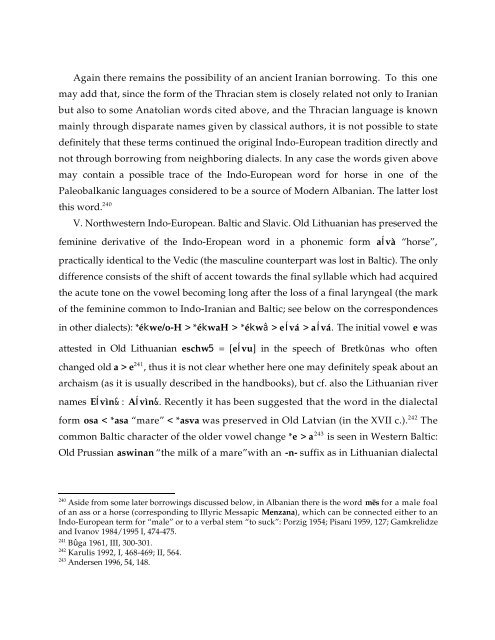Comparative Notes on Hurro-Urartian, Northern Caucasian
Comparative Notes on Hurro-Urartian, Northern Caucasian
Comparative Notes on Hurro-Urartian, Northern Caucasian
Create successful ePaper yourself
Turn your PDF publications into a flip-book with our unique Google optimized e-Paper software.
Again there remains the possibility of an ancient Iranian borrowing. To this <strong>on</strong>e<br />
may add that, since the form of the Thracian stem is closely related not <strong>on</strong>ly to Iranian<br />
but also to some Anatolian words cited above, and the Thracian language is known<br />
mainly through disparate names given by classical authors, it is not possible to state<br />
definitely that these terms c<strong>on</strong>tinued the original Indo-European traditi<strong>on</strong> directly and<br />
not through borrowing from neighboring dialects. In any case the words given above<br />
may c<strong>on</strong>tain a possible trace of the Indo-European word for horse in <strong>on</strong>e of the<br />
Paleobalkanic languages c<strong>on</strong>sidered to be a source of Modern Albanian. The latter lost<br />
this word. 240<br />
V. Northwestern Indo-European. Baltic and Slavic. Old Lithuanian has preserved the<br />
feminine derivative of the Indo-Eropean word in a ph<strong>on</strong>emic form aÍvà “horse”,<br />
practically identical to the Vedic (the masculine counterpart was lost in Baltic). The <strong>on</strong>ly<br />
difference c<strong>on</strong>sists of the shift of accent towards the final syllable which had acquired<br />
the acute t<strong>on</strong>e <strong>on</strong> the vowel becoming l<strong>on</strong>g after the loss of a final laryngeal (the mark<br />
of the feminine comm<strong>on</strong> to Indo-Iranian and Baltic; see below <strong>on</strong> the corresp<strong>on</strong>dences<br />
in other dialects): *é´kwe/o-H > *é´ ´kwaH > *é´ ´kwâ > eÍvá > aÍvá. The initial vowel e was<br />
attested in Old Lithuanian eschw5 = [eÍvu] in the speech of Bretkûnas who often<br />
changed old a > e 241 , thus it is not clear whether here <strong>on</strong>e may definitely speak about an<br />
archaism (as it is usually described in the handbooks), but cf. also the Lithuanian river<br />
names EÍvìn& : AÍvìn&. Recently it has been suggested that the word in the dialectal<br />
form osa < *asa “mare” < *asva was preserved in Old Latvian (in the XVII c.). 242 The<br />
comm<strong>on</strong> Baltic character of the older vowel change *e > a 243 is seen in Western Baltic:<br />
Old Prussian aswinan “the milk of a mare”with an -n- suffix as in Lithuanian dialectal<br />
240 Aside from some later borrowings discussed below, in Albanian there is the word mës for a male foal<br />
of an ass or a horse (corresp<strong>on</strong>ding to Illyric Messapic Menzana), which can be c<strong>on</strong>nected either to an<br />
Indo-European term for “male” or to a verbal stem “to suck”: Porzig 1954; Pisani 1959, 127; Gamkrelidze<br />
and Ivanov 1984/1995 I, 474-475.<br />
241 Bûga 1961, III, 300-301.<br />
242 Karulis 1992, I, 468-469; II, 564.<br />
243 Andersen 1996, 54, 148.





